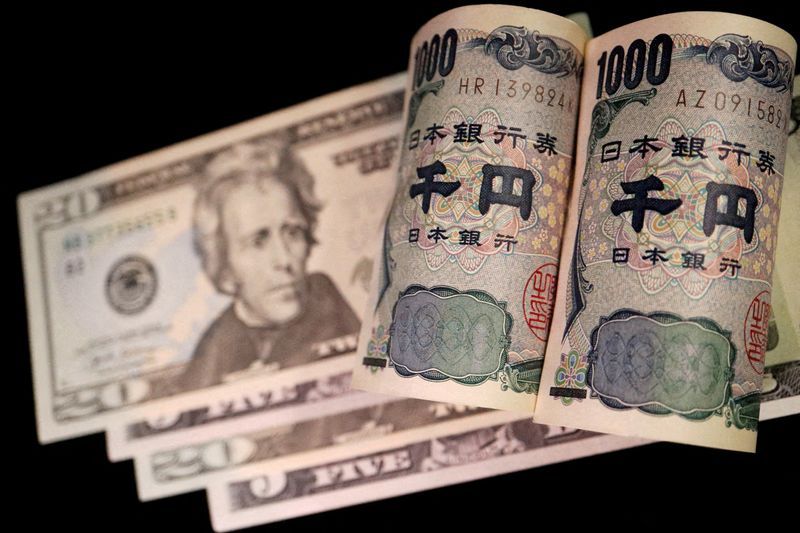By Gertrude Chavez-Dreyfuss
NEW YORK (Reuters) -The dollar surged to a fresh 34-year high against the yen on Friday, bolstered in part by U.S. inflation data that showed no signs of easing, coming in line with forecasts and affirming expectations that the Federal Reserve will likely delay cutting interest rates to later this year.
The dollar's peak against the yen came after the Bank of Japan kept interest rates steady at its end of its two-day policy meeting, although it flagged future rate hikes. With the yen at multi-decade lows, market participants were on alert for possible intervention from Japan to prop up its currency.
The dollar hit 157.795 yen, the highest since June 1990, and was last up 1.3% at 157.71. The greenback briefly dropped as low as 154.97 earlier in the session, triggering speculation that the BOJ, which acts on the behalf of the Ministry of Finance, may have checked currency rates, supposedly a sign that the central bank is preparing to intervene.
It was not immediately clear what caused the move.
The greenback was on track for a 2% weekly gain against the Japanese currency, the largest since mid-January.
In the United States, the focus was on inflation.
The personal consumption expenditures (PCE) price index rose 0.3% in March, compared to a forecast of a 0.3% increase, data showed. In the 12 months through March, PCE inflation advanced 2.7% against expectations of 2.6%.
The PCE price index is one of the inflation measures tracked by the Fed for its 2% target. Monthly inflation readings of 0.2% over time are necessary to bring inflation back to target.
"While the Friday result wasn't quite as hot as the whisper number, the stark reality is that short-term trends on the Fed's favored inflation gauge have steadily headed due north since the start of 2024," wrote Douglas Porter, chief economist at BMO.
Porter added that the monthly rise of 0.32% prompted a small market sigh of relief, but noted that the figure would have matched the fastest monthly rise in the decade prior to the pandemic.
"That's hardly going to give the Fed 'confidence' that inflation is calming," Porter wrote.
Post-inflation data, U.S. rate futures have priced in a 58% chance of a Fed cut at the September meeting, down from 68% a week ago, according to the CME's FedWatch tool. A Fed easing is priced more than 80% in December.
In afternoon trading, the dollar index was up 0.3% at 105.93.
The euro fell 0.2% to $1.0705. On the week, it was up 0.4%, on pace for its largest weekly rise since early March.
Versus the yen, the euro hit a new 16-year peak of 168.85 yen. It last traded at 168.845, up 1.1%.
On a weekly basis, the single European currency rose 2.5% against the yen, poised for its best showing since mid-June 2023.
Sterling slipped 0.1% to $1.2501. It rose 1.1% against the dollar on the week, its largest gain since early March.
In Japan, the BOJ left its short-term interest rate target at 0-0.1% on Friday and made small upward adjustments in its inflation forecast. Investors had not expected a policy shift but took the decision as confirmation that only small moves lie ahead.
BOJ Governor Kazuo Ueda told a press conference after the rate decision that monetary policy did not directly targetcurrency rates, but exchange-rate volatility could have a significant impact on the economy and prices.
"If yen moves have an effect on the economy and prices that is hard to ignore, it could be a reason to adjust policy," Ueda said.
Currency investors are now focused on next week's Federal Open Market Committee (FOMC), in which the U.S. central bank is expected to hold interest rates steady.

The market is positioned for a hawkish Fed at the meeting and a stronger dollar given the run of better-than-expected economic data.
Brian Dangerfield, head of G10 FX strategy, U.S. at NatWest (LON:NWG), wrote in a research note that the bank believes Fed Chair Jerome Powell will not rule out rate hikes, prerequisite for having a data-dependent policy. A rate hike, however, is not the FOMC's base case, Dangerfield added.
